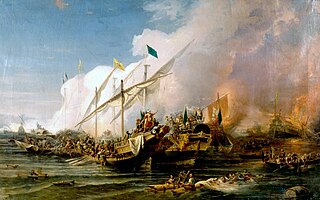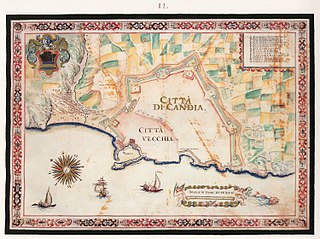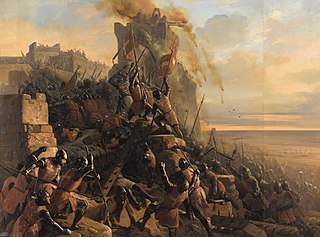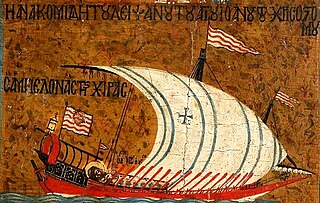
The Battle of Lepanto was a naval engagement that took place on 7 October 1571 when a fleet of the Holy League, a coalition of Catholic states arranged by Pope Pius V, inflicted a major defeat on the fleet of the Ottoman Empire in the Gulf of Patras. The Ottoman forces were sailing westward from their naval station in Lepanto when they met the fleet of the Holy League which was sailing east from Messina, Sicily.

The Battle of Preveza was a naval engagement that took place on 28 September 1538 near Preveza in the Ionian Sea in northwestern Greece between an Ottoman fleet and that of a Holy League. The battle was an Ottoman victory which occurred in the same area in the Ionian Sea as the Battle of Actium in 31 BC. It was one of the three largest sea battles that took place in the sixteenth century Mediterranean, along with the Battle of Djerba and the Battle of Lepanto.

The Holy League of 1571 was arranged by Pope Pius V and included the major Catholic powers of southern Europe, specifically the Spanish Empire as well as the Italian maritime powers. It was intended to break the Ottoman Empire’s control of the eastern Mediterranean Sea and was formally concluded on 25 May 1571.
This battle was fought on 10 July 1651, with some minor fighting on 8 July, between the islands of Paros and Naxos in the Aegean Sea, between the Venetian and Ottoman fleets. It was a Venetian victory, but failed to achieve anything decisive.

Martino Zaccaria was the Lord of Chios from 1314 to 1329, ruler of several other Aegean islands, and baron of Veligosti–Damala and Chalandritsa in the Principality of Achaea. He distinguished himself in the fight against Turkish corsairs in the Aegean Sea, and received the title of "King and Despot of Asia Minor" from the titular Latin Emperor, Philip II. He was deposed from his rule of Chios by a Byzantine expedition in 1329, and imprisoned in Constantinople until 1337. Martino then returned to Italy, where he was named the Genoese ambassador to the Holy See. In 1343 he was named commander of the Papal squadron in the Smyrniote crusade against Umur Bey, ruler of the Emirate of Aydin, and participated in the storming of Smyrna in October 1344. He was killed, along with several other of the crusade's leaders, in a Turkish attack on 17 January 1345.

The Cretan War, also known as the War of Candia or the fifth Ottoman–Venetian war, was a conflict between the Republic of Venice and her allies against the Ottoman Empire and the Barbary States, because it was largely fought over the island of Crete, Venice's largest and richest overseas possession. The war lasted from 1645 to 1669 and was fought in Crete, especially in the city of Candia, and in numerous naval engagements and raids around the Aegean Sea, with Dalmatia providing a secondary theater of operations.

The Battle of Settepozzi was fought in the first half of 1263 off the Greek island of Settepozzi between a Genoese–Byzantine fleet and a smaller Venetian fleet.

The Smyrniote crusades (1343–1351) were two Crusades sent by Pope Clement VI against the Beylik of Aydin under Umur Bey which had as their principal target the coastal city of Smyrna in Asia Minor. The crusade was mostly successful in restricting piracy and leading to Umur's death and Smyrna remained in Latin hands until 1402.
Henry of Asti was the titular Latin Catholic patriarch of Constantinople from 1339 and bishop of Negroponte in Frankish Greece. His fame rests on his leadership of the first Smyrniote crusade (1342–45), on which he died.
The Battle of Chios was a naval battle fought off the shore of the eastern Aegean island of Chios between a Latin Christian—mainly Hospitaller—fleet and a Turkish fleet from the Aydinid emirate. The Christian fleet was victorious, but for the Aydinids, who had been engaging in piracy since the collapse of Byzantine power, it was only a temporary setback in their rise to prominence.

Pietro Zeno was the Venetian captain and bailiff of Negroponte (1331–33) and one of the leaders of the Smyrniote crusade (1343–45).

The Hospitaller conquest of Rhodes took place in 1306–1310. The Knights Hospitaller, led by Grand Master Foulques de Villaret, landed on the island in summer 1306 and quickly conquered most of it except for the city of Rhodes, which remained in Byzantine hands. Emperor Andronikos II Palaiologos sent reinforcements, which allowed the city to repel the initial Hospitaller attacks, and persevere until it was captured on 15 August 1310. The Hospitallers transferred their base to the island, which became the centre of their activities until it was conquered by the Ottoman Empire in 1522.
The Battle of Amorgos occurred in 1312 between the fleets of the Knights Hospitaller and of the Turkish beylik of Menteshe. The battle was a Hospitaller victory, but both sides suffered heavy losses.
The Battle of Pallene occurred in 1344 between the fleets of a Latin Christian league and Turkish raiders, at the Pallene Peninsula in northern Greece.
The Battle of Megara occurred in 1359 between an alliance of the Christian states of southern Greece, and of a Turkish raiding fleet. The battle was a victory for the allies.

The Battle of Adramyttion occurred in autumn 1334 between the fleets of a Christian naval league, headed by the Republic of Venice and the Knights Hospitaller, and of the Turkish beylik of Karasi. The battle was a Christian victory.

The Battle of Gallipoli occurred on 29 May 1416 between the fleets of the Republic of Venice and the Ottoman Empire off the port city of Gallipoli, the main Ottoman naval base. The battle was the main episode of a brief conflict between the two powers, resulting from Ottoman attacks against possessions and shipping of the Venetians and their allies in the Aegean Sea in 1414–1415. The Venetian fleet, under Pietro Loredan, was charged with transporting a Venetian embassy to the Ottoman sultan, but was authorized to attack if the Ottomans refused to negotiate. The subsequent events are known chiefly from a detailed letter written by Loredan after the battle.
The Battle of Imbros occurred in spring 1347 between the fleets of a Christian naval league formed as part of the Smyrniote crusades, and of a Turkish raiding fleet, possibly from the beyliks of Aydin and Sarukhan. The Turks abandoned their ships and landed on the island of Imbros, where most were captured.

The Crusades after the fall of Acre, 1291–1399 represent the later Crusades that were called for by papal authorities in the century following the fall of Acre and subsequent loss of the Holy Land by the West in 1302. These include further plans and efforts for the recovery of the Holy Land, the later popular Crusades, Crusades against Christians, political Crusades, the latter parts of the Reconquista, and the Northern Crusades. Crusades were to continue well into the fifteenth century and would include those against the Ottoman Empire.
In 1320, the Turks of Menteshe launched an unsuccessful attempt to conquer the island of Rhodes from the Knights Hospitaller.









